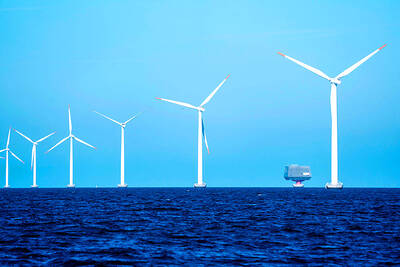Nazir Mirani, 47, is the third generation of a humble family committed to saving Pakistan’s blind dolphins, an endangered species swimming against a tide of manmade hazards.
“I treat them as my children and do everything whenever a dolphin is trapped in shallow waters,” said Mirani, once a fisherman and now among a handful of people officially assigned to protect the dolphins.
“No one can know them as meticulously as me. I was born in a boat and have been living with these fish ever since,” said the lanky Mirani, his complexion darkened by years under the burning sun and his chest puffed up with pride.
“Look at my eyes,” he said. “Aren’t they shaped like the fish?”
Indus dolphins — Platanista gangetica minor or bulhan in the local Sindhi language — are listed as endangered by the World Conservation Union.
According to local folklore, a lactating woman once refused to give milk to a saint, who cursed her and pushed her into the Indus. The woman turned into a dolphin and the freshwater species was born.
Females are bigger than males, weighing up to 110kg and growing up to 2.5m long.
The brownish-pink mammals have lived alongside humans for time immemorial. Their long, pointed snouts thicken at the end, and the upper and lower teeth are visible even when the mouth is closed.
Their numbers are declining as fishermen deplete their stock of food, pollution worsens and a network of barrages restricts their movements. Falling water levels because of declining rain and snowfall are another peril.
The Worldwide Fund For Nature Pakistan estimated in 2006 there were around 1,200 Indus dolphins left — 900 at a sanctuary near Sukkur in the southern province of Sindh and another 300 further upstream in Punjab.
The dolphin is blind because it lacks eye lenses and so hunts for catfish and shrimp using sophisticated sonar, said Hussain Bux Bhagat, a senior official in the Sindh wildlife department.
Dolphins swam freely in the Indus until about a century ago when engineers under British rule started slicing up the river with irrigation projects in the dry hinterland.
The barrages pose a critical threat to the dolphins, dividing their natural habitat into five separate segments of the snaking river.
“This species used to roam across 3,500km of the Indus but are now confined to 900km,” Bhagat said.
As a result the risk of inbreeding “could lead to infertility and then extinction,” Bhagat said.
An alarming increase in pollution from untreated sewage dumps, illegal pesticides and industrial and agricultural waste also threaten their survival.
The dolphins swim on their sides, trailing a flipper along the river bottom and can move in water as shallow as 30cm.
But each year up to 50 dolphins get trapped in the thousands of kilometers of irrigation channels, which are closed and left to dry out.
Fishermen used to kill them but awareness campaigns have improved to the extent that they now inform wildlife officials who come to their rescue.
“People were so uneducated they used to shoot the dolphins dead until a few years ago,” Bhagat said.
The trouble is that wildlife services have limited resources. Rescuers have just one van with a water tub, which they use to keep the dolphins alive for a few hours while they take them back to the river.
“We have successfully rescued 50 dolphins this season, but we could do it more efficiently if we get a helicopter,” Bhagat said.

FRUSTRATIONS: One in seven youths in China and Indonesia are unemployed, and many in the region are stuck in low-productivity jobs, the World Bank said Young people across Asia are struggling to find good jobs, with many stuck in low-productivity work that the World Bank said could strain social stability as frustrations fuel a global wave of youth-led protests. The bank highlighted a persistent gap between younger and more experienced workers across several Asian economies in a regional economic update released yesterday, noting that one in seven young people in China and Indonesia are unemployed. The share of people now vulnerable to falling into poverty is now larger than the middle class in most countries, it said. “The employment rate is generally high, but the young struggle to

STEPPING UP: Diminished US polar science presence mean opportunities for the UK and other countries, although China or Russia might also fill that gap, a researcher said The UK’s flagship polar research vessel is to head to Antarctica next week to help advance dozens of climate change-linked science projects, as Western nations spearhead studies there while the US withdraws. The RRS Sir David Attenborough, a state-of-the-art ship named after the renowned British naturalist, would aid research on everything from “hunting underwater tsunamis” to tracking glacier melt and whale populations. Operated by the British Antarctic Survey (BAS), the country’s polar research institute, the 15,000-tonne icebreaker — boasting a helipad, and various laboratories and gadgetry — is pivotal to the UK’s efforts to assess climate change’s impact there. “The saying goes

ENERGY SHIFT: A report by Ember suggests it is possible for the world to wean off polluting sources of power, such as coal and gas, even as demand for electricity surges Worldwide solar and wind power generation has outpaced electricity demand this year, and for the first time on record, renewable energies combined generated more power than coal, a new analysis said. Global solar generation grew by a record 31 percent in the first half of the year, while wind generation grew 7.7 percent, according to the report by the energy think tank Ember, which was released after midnight yesterday. Solar and wind generation combined grew by more than 400 terawatt hours, which was more than the increase in overall global demand during the same period, it said. The findings suggest it is

TICKING CLOCK: A path to a budget agreement was still possible, the president’s office said, as a debate on reversing an increase of the pension age carries on French President Emmanuel Macron yesterday was racing to find a new prime minister within a two-day deadline after the resignation of outgoing French Prime Minister Sebastien Lecornu tipped the country deeper into political crisis. The presidency late on Wednesday said that Macron would name a new prime minister within 48 hours, indicating that the appointment would come by this evening at the latest. Lecornu told French television in an interview that he expected a new prime minister to be named — rather than early legislative elections or Macron’s resignation — to resolve the crisis. The developments were the latest twists in three tumultuous